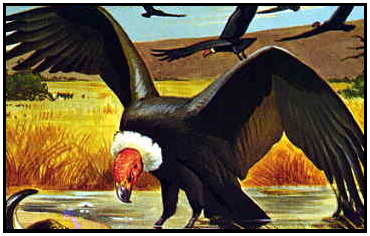TeratornsOrder: Falconiformes. Family: Teratornithidae. An early relative of the stork and New World vultures. Ancestor of the California Condor. Scientific Names: Argentavis magnificens, Teratornia incredibilis (translation: 'the incredible giant bird') and Teratornis merriami. Common Names: Teratorns or Merriam's Teratorn. Conservation Status: Extinct. It is likely the Teratorns disappeared due to a severe reduction in their food. Rescue & Recovery: Not applicable. Geographical Range: California (Teratornia incredibilis and Teratornis merriami) and Argentina (Argentavis magnificens). Habitat: Merriam's Teratorn (California) has been found in sizeable numbers at the La Brea Tar Pits, where they were probably caught in the tar while scavenging or hunting trapped animals.
Terratorn Trapped in La Brea Tar PitsPhysical Characteristics: The Teratorns were a group of giant condor-like vultures that lived in the Miocene period some five to eight million years ago. The title of largest-ever flying bird goes to Argentavis magnificens which stood an impressive 1.5 metres tall and possessed a wing which measured some 1.2 metres from front to back. Estimates put its weight at about 120 kilograms and body length at 3.4 metres long from beak-tip to tail. It has been questioned as to whether a bird of this size could, in fact, have ever flown, but examinations of the wing bones have identified they are of a correct size to accomplish the no mean feat of getting the enormous body off the ground. Impressions of feathers and marks on the wing bones where feathers would have been attached are also obvious. The largest flight feathers are thought to have been 1.5 metres long and eighteen centimetres wide. The logical assumption is that if it possessed the wings and feathers for flight, it must have been able to do so. Their actual appearance remains unknown, because items like skin, fur and feathers are rarely preserved, so experts must make educated guesses on how these animals appeared, based partly upon their modern relatives. Food: Teratorns were predatory birds with narrow hooked beaks and jaws; it is thought that they probably ate small animals such as mice, fish, young birds, lizards and frogs, which they probably swallowed whole. Along with this, the fossilised skeletons of hare-like rodents and armadillos have been found nearby and so may also have been on the menu. Reproduction: Unknown.
|

